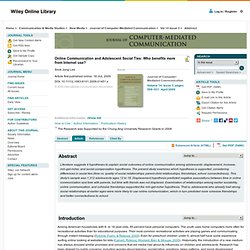

Social Media isn't for Learning - Long View on Education. Study Weighs Academic Effects of Sports, Early Sex, Bullying on Teenagers - Inside School Research. 287539. Teens, kindness and cruelty on social network sites. Social media use has become so pervasive in the lives of American teens that having a presence on a social network site is almost synonymous with being online.

Fully 95% of all teens ages 12-17 are now online and 80% of those online teens are users of social media sites. Many log on daily to their social network pages and these have become spaces where much of the social activity of teen life is echoed and amplified—in both good and bad ways. We focused our attention in this research on social network sites because we wanted to understand the types of experiences teens are having there and how they are addressing negative behavior when they see it or experience it.
As they navigate challenging social interactions online, who is influencing their sense of what it means to be a good or bad “digital citizen”? How often do they intervene to stand up for others? In our survey, we follow teens’ experiences of online cruelty – either personally felt or observed – from incident to resolution. For Teens 'Going Online' Usually Means 'Going on Facebook' Social media use has become so pervasive in the lives of American teens that having a presence on a social networking site, Facebook in particular, is almost synonymous with being online, according to a report by Pew Research.

Among key findings issued by Pew: More Teens Twitter but Facebook Still Rules. U.S. Kids Looking Forward to “iHoliday” 2011. As Black Friday and the holiday season approaches, Apple appears to be the consumer electronics brand to beat.

A recent Nielsen survey shows kids’ holiday gaming and electronics appetites are whet by a number of top-selling Apple devices - with the iPad leading the pack. Consistent with U.S. kids’ 2010 wish lists, the Apple iPad is the most desired consumer electronic among kids ages 6-12 for holiday 2011. In fact, the iPad increases its stronghold, with nearly half (44%) of kids expressing interest in the product, up from 31 percent in 2010. Two other popular Apple devices – iPod Touch (30%) and iPhone (27%) – round out kids’ top three, with computers and other tablet brands each appealing to a quarter of younger consumers.
Many kids will also ask for gaming devices this year, with two products that offer unique gaming technologies – Nintendo 3DS (25%) and Kinect for Xbox 360 (23%) – leading the way. U.S. Teen Mobile Report: Calling Yesterday, Texting Today, Using Apps Tomorrow. If it seems like American teens are texting all the time, it’s probably because on average they’re sending or receiving 3,339 texts a month.

That’s more than six per every hour they're awake – an 8 percent jump from last year. Using recent data from monthly cell phone bills of more than 60,000 mobile subscribers as well as survey data from over 3,000 teens, The Nielsen Company analyzed mobile usage data among teens in the United States for the second quarter of 2010 (April 2010 – June 2010). No one texts more than teens (age 13-17), especially teen females, who send and receive an average of 4,050 texts per month. Teen males also outpace other male age groups, sending and receiving an average of 2,539 texts.
Young adults (age 18-24) come in a distant second, exchanging 1,630 texts per month (a comparatively meager three texts per hour). Number One Reason for Getting a Phone? Texting is Easier and Faster than Voice Calls All of this texting activity has come at the expense of voice. Teens ditch e-mail for texting and Facebook - Technology & science - Tech and gadgets. Online Communication and Adolescent Social Ties: Who benefits more from Internet use?* - Lee - 2009 - Journal of Computer-Mediated Communication.
Abstract Literature suggests 4 hypotheses to explain social outcomes of online communication among adolescents: displacement, increase, rich-get-richer, and social-compensation hypotheses.

The present study examines which hypothesis is supported, considering differences in social ties (time vs. quality of social relationships; parent-child relationships; friendships; school connectedness). This study's sample was 1,312 adolescents ages 12 to 18. Displacement hypothesis predicted negative associations between time in online communication and time with parents, but time with friends was not displaced. Texting as a life phase medium - Ling - 2010 - Journal of Computer-Mediated Communication. Abstract SMS has grown to be a common form of interaction in Norwegian society.

Its adoption started among teens but has since been taken into use by other age groups. However, the use patterns for teens seem to be different from those of older users. This paper examines the assertion that SMS is a life phase and not a cohort phenomenon. That is, its use is more intense among teens and more moderate among older age groups. Introduction Text messages1 became popular in Norway in the mid 1990s. Gender, Communication, and Self-Presentation in Teen Chatrooms Revisited: Have Patterns Changed? - Kapidzic - 2011 - Journal of Computer-Mediated Communication. Abstract This study evaluates empirically the proposition implicit in much recent gender and CMC research that expressions of gender distinctness among teens in online environments are becoming less frequent and less traditional.

Gender preferences were analyzed in linguistic features and communication styles in synchronous text messages, along with self-presentation in user profile pictures, drawing on data from popular English-language teen chat sites collected in 2010. Significant differences were found in speech acts, message tone, and in physical stance, dress, and social distance in profile pictures that generally conform to traditional gender stereotypes. These findings are interpreted in light of previous gender and teen CMC research, adolescent development and socialization patterns, mass media representations, and trends towards media convergence in chat platforms.
The picture for chat environments has always been less clear. Background Thelwall et al.' H2a. H2b. H3a. IMing, Text Messaging, and Adolescent Social Networks. Text messaging explodes as teens embrace it as the centerpiece of their communication strategies with friends.